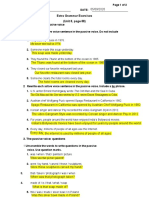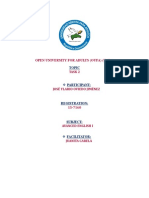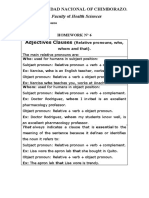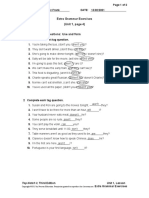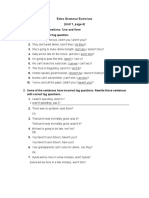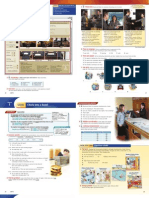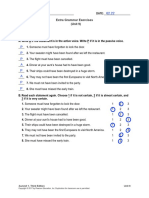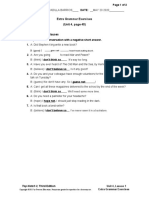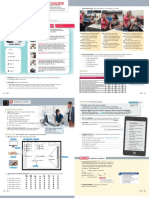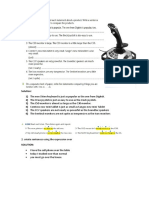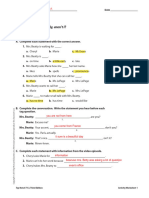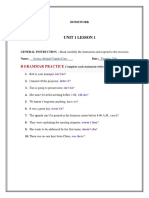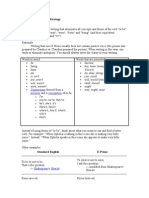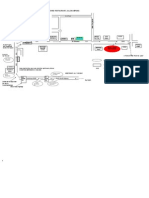Level 3 Workbook Unit 1
Level 3 Workbook Unit 1
Uploaded by
Taty Cerrato de JorqueraCopyright:
Available Formats
Level 3 Workbook Unit 1
Level 3 Workbook Unit 1
Uploaded by
Taty Cerrato de JorqueraOriginal Title
Copyright
Available Formats
Share this document
Did you find this document useful?
Is this content inappropriate?
Copyright:
Available Formats
Level 3 Workbook Unit 1
Level 3 Workbook Unit 1
Uploaded by
Taty Cerrato de JorqueraCopyright:
Available Formats
UNIT
1 Make Small Talk
p r e v ie w
1 Read the tips on business etiquette. Then read the situations below. Decide if the behavior in each
situation is appropriate or inappropriate.
TIPS ON BUSINESS ETIQUETTE
} Always introduce the most important
person first.
} Use your business card as a way to stay in
touch with people you meet. Exchanging and
saving business cards can help you “network”
with people later.
} Being on time is absolutely necessary for
business appointments. The rule is to arrive
ten to fifteen minutes early. However, for
social events, such as business parties, it is
considered impolite to arrive early.
} In major cities, business clothing is usually formal. Blue, black, or gray suits are
conservative and always appropriate. In warm climates, neat and comfortable khakis,
jeans, or slacks, sometimes with a jacket, are OK. However, the first time you visit a
company, it is always best to start with a conservative look.
} Business conversations often take place during meals. The meals are a time to relax,
get to know the other person socially, and then talk a little business. Depending on
the person’s schedule, these meetings can be at breakfast, lunch, or dinner.
} Eye contact is very important. Always look at everyone in your conversation group.
Move your eyes from one person to another. It makes people feel important and
holds their attention.
1. While you’re meeting with a client, the CEO of your company
and two executives come into your office. You introduce the X appropriate inappropriate
CEO to your client first.
2. You are meeting with a group of four people. While speaking,
you’re looking only at the highest level manager in the group. appropriate X inappropriate
3. You have an interview at a new company on Friday. You
know the company allows employees to dress casually on
Fridays, so you decide to wear casual clothing. appropriate X inappropriate
4. You don’t have time during regular business hours to meet with
a client. You decide to meet over dinner. X appropriate inappropriate
5. You’re invited to a business party and the invitation says the
party is from 7:0 0 to 9:0 0 . . You arrive at 6:45. appropriate X inappropriate
M01_TOPN_WB_03_2817_U01.indd 1 11/11/14 10:21 AM
2 Match the correct response to each statement or question. Write the letter on the line.
1. N ice to meet you. C a. N ot really. People tend to be more formal here.
e b. Please call me by my nickname.
2. What is the custom here?
3. How would you like to be called?
b c. N ice to meet you, too.
4. Are most people on a first-name basis? a d. N o need to be so formal. Please call me Robert.
5. N ice to meet you, Mr. Reston. d e. I’m not sure. It’s probably best to watch what
others do.
3 WHAT ABOUT YOU? A nswer the questions in your own way.
1. What do you prefer to be called by your family?
by my nickname
2. What do you like to be called by your friends? by my name
3. What do you prefer to be called by your colleagues or classmates? by my name
LESSON 1
4 Put the conversation in the correct order. Write the number on the line.
1 Hi! It’s a great day, isn’t it?
4 N ice to meet you, too. Would it be rude to call you Joe?
2 It really is. Allow me to introduce myself. I’m Amanda Decker.
5 Absolutely not. Please do.
6 Great. And call me Amanda.
3 I’m Joe Hanson. It’s nice to meet you.
5 Complete each statement with a tag question.
1. He didn’t know about that custom,
did he ?
2. It’s a great day to go to the beach, isn't
it ?
3. You learned Japanese in school, didn't you ?
4. Mike will be here later, won't he ?
5. You’re not from Turkey, are you ?
6. The program in Bali wasn’t very successful, was it ?
7. I' m presenting my report at 2,
aren't I ?
8. There weren’t a lot of people at the conference,
were there ?
2 UNIT 1
M01_TOPN_WB_03_2817_U01.indd 2 11/11/14 10:21 AM
6 Read the situations and complete the tag questions.
1. You think your friend got a good grade on her science test.
“She g o t a good grade on her science test, di dn ’ t s h e ?”
2. You see two people talking, but you don’t think that they know each other.
“They do n ’ t k n o w each other, do t h e y ?”
3. You’re talking to your friend. You think he’ll be late to the party tonight.
“You will late to the party tonight,
'll be; won't you ?”
4. When you get to class, you think your friend Diane hasn’t gotten there yet.
“Diane
hasn’t gotten here yet,
has she ?”
5. You heard that your friend Bill was in a car accident yesterday, but you don’t think that’s true.
wasn’t; was he
“Bill in a car accident yesterday, ?”
6. You think that Dr. Jenkins doesn’t like to be called by her first name.
“Dr. Jenkins doesn’t like to be called Kate, does she ?”
7 Read the information about A llison McFarland. Then use the information on the form to write
statements with tag questions.
Nam e: Ali s o n M cF ar la nd
Pref erd t i t l e: M s.
D at e of b i rt h : O ct o be r 2 7 , 1 9 9 5
Pl ace of b i rt h : H o ng K o ng
C ou n t ry of resi d en ce: C ana da
Occu p at i on : s t u de nt
1. Y o u ’ r e A l l i s o n M cF ar l an d, ar e n ’ t y o u ?
2. You’re not married, are you?
3. You like to be addressed by your first name, don’t you?
4.
You are 25 years old, aren’t you?
5. You don’t live in Hong Kong, do you?
8 WHAT ABOUT YOU? Which topics are appropriate for small talk in your country? Check yes or no.
If you check no, then explain why the topic is not appropriate.
yes no
1. what someone would like to be called X
2. how much money a person makes X
3. a person’s work or studies X
4. someone’s marital status X
M a k e Sm a l l Ta l k 3
M01_TOPN_WB_03_2817_U01.indd 3 11/11/14 10:21 AM
LESSON 2
9 Look at K en K lein’s weekly planner. Then circle the letter of the answer that completes each
sentence. Today is Sunday.
M ON D AY T H U R S D AY
12:00 travel to Copenhagen 9:00 read TechServe report
7:00 meet Jason Bailey for dinner 1:00 have meeting with TechServe
TUE SD AY F R ID AY
8:30 have meeting with Computech 8:00 have meeting with Nelson Company
12:30 prepare client presentation 3:00 present results of Nelson Company
meeting
8:30 fly home to London
WE D N E SD AY S AT URD AY S UN D AY
9:00 fly to Brussels relax all afternoon! exercise in morning
1:30 meet Clark Sampson for lunch at gym
7:45 go to the movies
4:00 give presentation to clients with Tania
7:30 take clients to dinner
1. By 5:0 0 . . on Monday, Ken
a to Copenhagen.
a. had already traveled b. hadn’t yet traveled
2. On Tuesday, Ken b Clark Sampson for lunch.
a. had already met b. hadn’t yet met
3. On Wednesday evening, Ken b to Brussels.
a. hadn’t yet flown b. had already flown
4. Ken a the results of the N elson Company meeting at 2:0 0 on Friday.
a. hadn’t yet presented b. had already presented
5. Ken
a
all week before he was able to relax on Saturday.
a. had worked b. hadn’t worked
10 Look at K en K lein’s weekly planner again. Complete the statements using the past perfect and
already or not yet.
1. By the time he flew to Brussels, Ken h ad al r e ady h ad the meeting with Computech, but he
h adn ’ t y e t h ad the meeting with TechServe.
2. At 7:0 0 . . on Wednesday, he
had already given the presentation to the clients, but he
hadn’t yet taken the clients to dinner.
3. Ken had already read the TechServe report when he had the meeting with TechServe.
4. Ken
hadn’t yet had the meeting with N elson Company when he had the meeting with
TechServe.
5. By Saturday evening, Ken hadn’t yet exercised
at the gym.
6. At 8:0 0 on Saturday, Ken
had already gone to the movies with Tania.
4 UNIT 1
M01_TOPN_WB_03_2817_U01.indd 4 11/11/14 10:21 AM
11 Read the Conversation Model on page 7 in the Student’s B ook again. Then read each sentence
below. Circle the letter of the sentence that has the same or similar meaning.
1. “By 9:0 0 I had already bought my books.” 3. “When I got to class, I hadn’t eaten yet.”
a. I bought my books before 9:0 0. a. I got to class after I ate.
b. I bought my books at 9:0 0. b. I got to class before I ate.
2. “What did you do about lunch?” 4. “I' ll bet you’re pretty hungry.”
a. Did you have lunch? a. I think you’re hungry now.
b. Do you want lunch? b. I’m sure you’re hungry now.
12 WHAT ABOUT YOU? Complete the sentences in your own way.
1. When I left the house this morning, I had already breakfast
.
2. At 8:0 0 today, I hadn’t yet started working
.
3. By the time I started to study English, I had already studied computing ,
but I hadn’t yet studied another language .
LESSON 3 D id y o u k n o w ...
that etiquette and rules
for behavior have a very
long history? The first
13 Cross out the word or phrase that has a instructions for etiquette
different meaning from the others. were written in the year
2400 B.C.E by an Egyptian
1. offensive very rude polite
named Ptahhotep. His
2. customary not allowed taboo guide included advice
about how to get along
3. impolite nice rude
with others and how to
4. not usual traditional customary advance in the world.
5. etiq uette punctuality manners
14 Read the article about punctuality. Then read the statements on page 6 and check true, false, or
no information, according to the article.
well as many government put up that remind people:
RIGHT ON TIME appointments and social “If you’re late, someone else
activities, begin late. The is waiting.” One newspaper
Everyone knows that different
cultures have different ideas group is trying to make people prints a list of government
about punctuality. But one aware of punctuality and is officials who arrive to events
country—Ecuador—is trying reminding them to be on time. late.
something new. The government, including The campaign has generally
the Ecuadorian president, is been well-received by the
A group called Citizens’
supporting the effort. Ecuadorian people, and it
Participation has found that
being late costs the country Hundreds of Ecuadorian seems to be working. Many
about $724 million each year. organizations and companies businesses have reported
They report that more than have signed agreements to be that more meetings are now
half of all public events, as on time. Posters have been beginning on time.
M a k e Sm a l l Ta l k 5
M01_TOPN_WB_03_2817_U01.indd 5 11/11/14 10:21 AM
true false no information
1. The country of Ecuador made more money because
people were often late. X
2. Citizens’ Participation doesn’t think punctuality is very
important. X
3. The government of Ecuador wants people to be on time. X
4. Signs and posters have been made to remind people to
be punctual. X
5. Punctuality is more important now in Ecuador than in
most other countries.
X
6. Ecuadorians are on time less often than they used to be. X
15 WHAT ABOUT YOU? H ow important is punctuality to you for each of the following events?
Explain your answers.
V ery Somewhat N ot
Why?
important important important
work or school X
dinner at a
friend’s house X
a meeting with
X
a co- worker
a doctor’s X
appointment
a movie X
BETTER THREE HOURS TOO SOON
THAN A MINUTE TOO LATE.
— W illiam Shakespeare, E ng l i sh p l ay w r i g ht a n d p o e t
LESSON 4
16 Read the article Global Culture on page 10 in the Student’s B ook again. Check each behavior that
would be considered unacceptable in the 1940 s according to Eugenia H artley. Then write the
EXTRA READING proper behavior next to it.
COMPREHENSION
You should arrive five minutes before the hour set for
1. You don’t join your family for dinner hour.
the dinner.
2. Children talk at the dinner table whenever they want.You should apologi before taking your seat.
3. People put their elbows on the table.
4. Children speak only when an adult speaks to them.
5. A girl stays out on a date past midnight. You should wait for others to be served before you start
eating.
6. Parents meet a daughter’s date before they go out. If you’re the hostess, you should wait until the guests are
done eating before leaving the table.
7. Children call adults by their first names.
You should wait at least 30 minutes before you leave.
6 UNIT 1
M01_TOPN_WB_03_2817_U01.indd 6 11/11/14 10:21 AM
17 Read the article and then circle the letter of the answer that best completes each sentence.
Dressing for Work
HOW CASUAL IS TOO CASUAL?
Thirty years ago or so, most people in the with each other. People enjoyed coming to work
United States, Canada, and Europe didn’t think knowing it was a comfortable place to be.
about what to wear to work in an office. Men
Then some people began to change their minds
always wore suits and ties. Women wore suits or
about casual dress at work. Many managers
conservative skirt outfits. But in the 1990s, that
felt that casual dress had led to casual attitudes
started to change.
toward work. Some people started to notice
It began with “casual Fridays.” During the an increase in employees being late to work. If
summer, some companies invited their “clothes make the man,” as the saying goes, then
employees to “dress down,” or wear more casual casual clothes make a casual person who is less
clothes to work on Fridays. The policy quickly committed to company productivity and quality.
became popular with employees. After this, it
One of the biggest reasons why there have
didn’t take long for employees to start dressing
been such mixed opinions about dressing down
more casually every day of the week.
is that there is no real standard for appropriate
Many employees welcomed the new dress policy casual dress. Is it shorts, T-shirts, brightly
and the more comfortable work environment that colored tops, and flip-flops? Is it designer jeans,
came with it. Etiquette had definitely changed, polo shirts, and trendy sneakers? Is it khakis
and suits and ties were rarely seen in many and sport jackets? Or are Hawaiian shirts
offices. Some employees went as far as wearing and torn jeans OK? Without a casual dress
jeans, T-shirts, and sneakers to the office. Many code policy, the etiquette for dress in many
people felt that casual attire made the workplace companies is beginning to change back to more
a friendlier place. Co- workers were more relaxed formal business attire—a style that everyone
understands.
casual (adjective):
1. not caring; 2. suitable for everyday use;
3. without attention; 4. not planned
1. Men used to wear a to work in an office.
a. suits b. conservative skirt outfits c. jeans and ties
b
2. Casual Fridays started .
a. about thirty years ago b. in the summer c. with women
a
3. Employees in most companies the idea of casual Fridays.
a. liked b. didn’t enjoy c. didn’t know about
b
4. N ow many managers think that employees should .
a. wear jeans b. not dress casually c. work on casual Friday
c
5. Etiq uette for dressing for work is once again becoming in many companies.
a. more casual b. less professional c. more professional
18 WHAT ABOUT YOU? A nswer the questions in your own way.
1. How has the etiq uette for dressing changed in your country?
Formal attire is currently used for the office or important events
2. Is this change for the better?
In some ways yes, it has improved the way people dress
M a k e Sm a l l Ta l k 7
M01_TOPN_WB_03_2817_U01.indd 7 11/11/14 10:21 AM
19 Read about N aomi’s problem and give her advice about the etiquette and cultural changes in
your country. U se ideas from the box or your own ideas.
clothing customs
“I’ve been out of the
dating customs
country for over fifteen
years. N ow I’m back, but forms of address
so much has changed. I male/female roles in the home
don’t know what to do.
Can you tell me about male/female roles in the workplace
the changes in etiq uette rules about formal behavior
and culture?”
rules about punctuality
table manners
Attire for the office remains formal, and table manners should always prevail,
although in some places attire can be comfortable.
GRAM M AR BOOSTER
A Complete the tag questions. Then look at the picture. A nswer each question with a short answer.
N ice to meet
you.
N ice to meet you,
too.
1. It’s a beautiful day today, i s n ’ t i t ? Y e s , it is .
2. It’s not 2:30 yet, i s i t ? N o , it is n ’ t .
3. It’s a good day to ride a bike, isn’t it ? Yes, it is.
4. The girl on the bike can’t see the car, can she ? No, she can’t.
wasn’t it No, it wasn’t.
5. Yesterday was Sunday, ?
6. The people haven’t met before today,
have they ? No, they haven’t.
are they ?
7. They’re not cold,
No, they aren’t.
8. The man plays tennis,
doesn’t he ? Yes, he does.
8 UNIT 1
M01_TOPN_WB_03_2817_U01.indd 8 11/11/14 10:21 AM
B Complete each sentence with the correct form of the words in parentheses. U se the present
continuous or the simple present tense.
1. It s o u n ds (sound) like they had a great vacation.
have
2. I (have) English class every Tuesday at 5:30.
3. The children are hungry, so I 'm making (make) them sandwiches.
4. Dr. Angle always tells (tell) her patients to exercise more.
is going
5. Our boss (go) to Cairo next Monday.
are
6. What you doing (do) tomorrow evening?
7. The bus
leaves (leave) at 3:0 0 on the weekends.
8. I ‘m baking (bake) a cake for Emma’s party tomorrow.
C Complete each sentence in the e-mail with the present perfect or the present perfect continuous.
Dear Sydney,
Hi! How are you? So far, I ‘ve been having a great time in Mexico. The sun
1. have
has been shining the whole time! I started my trip in Cancún, and spent a
2. shine
few days there. Now I’m in San Cristobál. I have been here
3. be
before, so it’s nice to be back. I have met some other travelers.
4. meet
Theyhave been travelingfor a long time, so they have a lot of great tips.
5. travel
We’re all going to Oaxaca next. I can’t wait!
Talk to you soon!
Chris
D Correct the verbs in the following sentences.
me t
1. Sheila was studying in London when she was meeting her boyfriend.
went
2. My family was going to Cairo last summer. It was a great trip!
known
3. They have know her since 2013.
use
4. He didn’t used to work there, but now he does.
was watching
5. I watched a movie when he called, but I didn’t mind the interruption.
have
6. I already seen that movie.
traveled
7. We have been traveling to Mexico three times.
M a k e Sm a l l Ta l k 9
M01_TOPN_WB_03_2817_U01.indd 9 11/11/14 10:21 AM
WRITING BOOSTER
A Match the emoticon and abbreviation with the phrase that has the same meaning. Write the
letter on the line.
1. b J a. “Let me know.”
2. d LOL b. “I’m smiling.”
3. f IMHO c. “I’m not happy.”
4.
c L d. “Laughing out loud”
5. h GR8 2 C U e. “By the way”
6. e BTW f. “In my humble opinion”
7. a LMK g. “See you later.”
8. g C U L8R h. “Great to see you.”
9. i R U OK? i. “Are you okay?”
B Complete the chart. Write the letter of the things you should do and the things you shouldn’t
do in formal e-mail etiquette.
a. Use a title, last name, and colon to address someone you don’t know well.
b. Write in complete sentences.
c. Use correct spelling.
d. Use emoticons.
e. Use all lower-case letters.
f. Punctuate carefully.
g. Date the e-mail.
h. End with your name.
i. Close the e-mail as a formal letter, for example, Thank you so much.
j. Include abbreviations.
k. Use a first name and comma to address someone you know well.
a b, c, f, h, i, k
Do’s:
Don’ts: d e, g, j
C Read the following e-mail and circle all the formal e-mail etiquette errors. Then, on a
separate sheet of paper, rewrite the e-mail and correct the etiquette errors.
Maria, Thanks 4 lunch yesterday. it was GR8 2 C U. let’s continue our conversation
about the project. maybe Wednesday next week? My place? There’s still lots 2 discus.
L BTW, please don’t forget to bring the info we talked about.
LMK about next week. C U L8R.
Peter Maria,
Thank you for lunch yesterday. It was great to see you.
Let’s continue our conversation about the project. Are you
available on Wednesday next week? Can you come to my
office? There’s still a lot to discuss. By the way, please don’t
10 UNIT 1 forget to bring the information we talked about.
Let me know about next week.
Thanks so much.
Peter Benson
M01_TOPN_WB_03_2817_U01.indd 10 11/11/14 10:21 AM
You might also like
- Unit 3Document11 pagesUnit 3Jenny Smilets100% (1)
- Autonomous Work Unit 2 5TH LevelDocument16 pagesAutonomous Work Unit 2 5TH LevelNile Martinez100% (1)
- Extra Grammar Exercises (Unit 2, Page 17) : Top Notch 3, Third EditionDocument4 pagesExtra Grammar Exercises (Unit 2, Page 17) : Top Notch 3, Third EditionalfredespinosaNo ratings yet
- Make A Small Talk Ingles WorkbookDocument7 pagesMake A Small Talk Ingles WorkbookAna Ruth GamezNo ratings yet
- Spending Habits Self-Test: Name: Jolenny Nicole de Paula Figueroa Matriculate: 2175904Document7 pagesSpending Habits Self-Test: Name: Jolenny Nicole de Paula Figueroa Matriculate: 2175904Dangy patrocia lara de jesusNo ratings yet
- Level 3 Student Book Unit 1Document12 pagesLevel 3 Student Book Unit 1Bassem MohamedNo ratings yet
- Top Noch 4-Activity 1Document4 pagesTop Noch 4-Activity 1Ana CandoNo ratings yet
- Lesson 1: Swimming Is My Favorite Activity I Love Swimming in The PoolDocument10 pagesLesson 1: Swimming Is My Favorite Activity I Love Swimming in The PoolNicol Villafuerte100% (2)
- Unit7 Teachers EditionDocument12 pagesUnit7 Teachers Editionalexis430% (1)
- Extra Grammar Exercises (Unit 8, Page 88) Lesson 1: The Passive VoiceDocument1 pageExtra Grammar Exercises (Unit 8, Page 88) Lesson 1: The Passive VoiceManuel67% (3)
- TP 03 Unit 06 Workbook AkDocument2 pagesTP 03 Unit 06 Workbook AkKosy Santana75% (16)
- George SorosDocument2 pagesGeorge SorosTaty Cerrato de Jorquera0% (1)
- Positional Play For 433 SampleDocument10 pagesPositional Play For 433 Samplesantiago socadagui100% (1)
- Draw Conclusions Answer The QuestionsDocument2 pagesDraw Conclusions Answer The QuestionsLuis BravoNo ratings yet
- Unit 2 Health MattersDocument9 pagesUnit 2 Health Matterscarlitamolina2No ratings yet
- First Mid Term TestDocument7 pagesFirst Mid Term TestJUAN DAVID MONTERROZA SIMPSON ESTUDIANTENo ratings yet
- Unit 4Document11 pagesUnit 4Andres Quino MelgarejoNo ratings yet
- Are You Weren't You Have They Had She Can't I Will You Didn't I Won't We Weren't They Aren't TheyDocument6 pagesAre You Weren't You Have They Had She Can't I Will You Didn't I Won't We Weren't They Aren't Theyanthony holguin100% (1)
- Ingles 2Document8 pagesIngles 2carlos figueroaNo ratings yet
- Unit 7Document11 pagesUnit 7Andres Quino MelgarejoNo ratings yet
- Avanced English Task 2Document9 pagesAvanced English Task 2jos oviedoNo ratings yet
- Josue David - TN3 - Unit - 6.HWDocument7 pagesJosue David - TN3 - Unit - 6.HWjasirNo ratings yet
- Top Notch 3 Workbook Answer Key: Unit 7Document4 pagesTop Notch 3 Workbook Answer Key: Unit 7Paola De Los Angeles Tigrero RodriguezNo ratings yet
- Arcos AndrWRFER - Homework N 6 Grammar Relative ClausesDocument4 pagesArcos AndrWRFER - Homework N 6 Grammar Relative ClausesDennys OrozcoNo ratings yet
- CC JaDocument3 pagesCC JaJessica CepedaNo ratings yet
- Pagina 72 y 84Document3 pagesPagina 72 y 84Edwards Albarracin100% (1)
- Extra Grammar Exercises (Unit 1, Page 4) : Top Notch 3, Third EditionDocument3 pagesExtra Grammar Exercises (Unit 1, Page 4) : Top Notch 3, Third Editionfrank xdNo ratings yet
- BÀI TẬP TUẦN 1 B2.4Document2 pagesBÀI TẬP TUẦN 1 B2.4phamhongthai5182005100% (1)
- Grammar Practice-UNIT 3Document4 pagesGrammar Practice-UNIT 3MARIBEL CUSI RONCONo ratings yet
- On-the-Street Interviews: I Think There's Too Much of It - .Document2 pagesOn-the-Street Interviews: I Think There's Too Much of It - .Fernando Moreno100% (1)
- Discuss Acts Ofkindness AndhonestyDocument11 pagesDiscuss Acts Ofkindness AndhonestyMARIBEL CUSI RONCO100% (1)
- UNIT 2 TASK 3 Advanced English IDocument4 pagesUNIT 2 TASK 3 Advanced English IRobert Arno Contreras50% (2)
- Extra Grammar Exercises (Unit 1, Page 4) LESSON 1 Tag Questions: Use and FormDocument4 pagesExtra Grammar Exercises (Unit 1, Page 4) LESSON 1 Tag Questions: Use and FormRonal Isak RTNo ratings yet
- Session 19 - B2.5Document8 pagesSession 19 - B2.5Hồng NguyễnNo ratings yet
- Unit3 Student BookDocument6 pagesUnit3 Student Bookopulento22No ratings yet
- Lesson 2: Extra Grammar Exercises (Unit 9)Document2 pagesLesson 2: Extra Grammar Exercises (Unit 9)Quỳnh NhiNo ratings yet
- Quiz 1 (Groupwork)Document5 pagesQuiz 1 (Groupwork)Davis Ingunza100% (1)
- Jessica Abigail Cepeda Coro Saturday 4: (Give) (Buy) (Pick Up) (Make) (Wash) (Lend)Document2 pagesJessica Abigail Cepeda Coro Saturday 4: (Give) (Buy) (Pick Up) (Make) (Wash) (Lend)Jessica CepedaNo ratings yet
- Universidad Tecnológica "Gral. Mariano Escobedo": Apodaca, Nuevo León, A 17 de Junio de 2019Document2 pagesUniversidad Tecnológica "Gral. Mariano Escobedo": Apodaca, Nuevo León, A 17 de Junio de 2019Chava MtzNo ratings yet
- Summit 1A Test - Unit 2 (WWW - Languagecentre.ir)Document11 pagesSummit 1A Test - Unit 2 (WWW - Languagecentre.ir)jad mamouNo ratings yet
- Summit 2 TE SampleDocument7 pagesSummit 2 TE SampleRichie BallyearsNo ratings yet
- Topnotch 2 Workbook 3ed PDFDocument97 pagesTopnotch 2 Workbook 3ed PDFGia Lôc0% (1)
- Extra Grammar Exercises (Unit 4, Page 40) : Noun ClausesDocument4 pagesExtra Grammar Exercises (Unit 4, Page 40) : Noun ClausesCaterine Padilla Barrios100% (1)
- Living in Cyberspace: PreviewDocument6 pagesLiving in Cyberspace: PreviewSantiago Gutiérrez0% (1)
- Unit 5Document11 pagesUnit 5Andres Quino MelgarejoNo ratings yet
- Extra Grammar Exercises Lesson 2 Unit7Document1 pageExtra Grammar Exercises Lesson 2 Unit7Cristina Galarza100% (1)
- AE - Tarea VIDocument4 pagesAE - Tarea VITumistrial PiernaNo ratings yet
- Review My Englis PearsonDocument1 pageReview My Englis PearsonvanessaNo ratings yet
- Créate Sentences Using The Expression OverDocument1 pageCréate Sentences Using The Expression Overjuan espinelNo ratings yet
- Group #1Document3 pagesGroup #1ronaldo suarezNo ratings yet
- English: Audioscript Conversation 1Document17 pagesEnglish: Audioscript Conversation 1Belencita ArguetaNo ratings yet
- TP 03 Unit 09 Workbook Ak PDFDocument1 pageTP 03 Unit 09 Workbook Ak PDFyulian100% (1)
- Unit 4 PracticeDocument6 pagesUnit 4 Practicedatsx1250No ratings yet
- UNIT 1 Top Notch TVDocument2 pagesUNIT 1 Top Notch TVsentidos188No ratings yet
- Ingles Avanza Ii Tarea 3 LuzDocument9 pagesIngles Avanza Ii Tarea 3 LuzluzhacttannyNo ratings yet
- UNIT 5 TASK 6 Advanced EnglishDocument4 pagesUNIT 5 TASK 6 Advanced EnglishRobert Arno ContrerasNo ratings yet
- CC JaDocument5 pagesCC JaJessica CepedaNo ratings yet
- TN3 Unit 7 Test-10-12Document6 pagesTN3 Unit 7 Test-10-12Samuel MuñozNo ratings yet
- Extra Grammar Exercises (Unit 4, Page 41) : Top Notch 2, Third EditionDocument3 pagesExtra Grammar Exercises (Unit 4, Page 41) : Top Notch 2, Third EditionNavud esoj100% (1)
- TN3 Review 1 - 5Document3 pagesTN3 Review 1 - 5UserMotMoo100% (1)
- Level 3 Workbook TALLERDocument10 pagesLevel 3 Workbook TALLEREdwards AlbarracinNo ratings yet
- Excerpt PDFDocument4 pagesExcerpt PDFLorena PinoNo ratings yet
- Your Results For: "Exercise 1"Document1 pageYour Results For: "Exercise 1"Taty Cerrato de JorqueraNo ratings yet
- Lionel Messi 2Document17 pagesLionel Messi 2Taty Cerrato de JorqueraNo ratings yet
- Animal TestingDocument1 pageAnimal TestingTaty Cerrato de JorqueraNo ratings yet
- The Anasazi PeopleDocument1 pageThe Anasazi PeopleTaty Cerrato de JorqueraNo ratings yet
- The Evolution of Tejano MusicDocument1 pageThe Evolution of Tejano MusicTaty Cerrato de JorqueraNo ratings yet
- Jane JacobsDocument1 pageJane JacobsTaty Cerrato de JorqueraNo ratings yet
- ISTJ - The Duty Fulfiller: Possible Career Paths For The INFPDocument2 pagesISTJ - The Duty Fulfiller: Possible Career Paths For The INFPTaty Cerrato de JorqueraNo ratings yet
- Your Results For: "Exercise 2"Document1 pageYour Results For: "Exercise 2"Taty Cerrato de JorqueraNo ratings yet
- Workbook Answer Key Unit 6: Correct Order: 3, 1, 4, 5, 2, 6Document2 pagesWorkbook Answer Key Unit 6: Correct Order: 3, 1, 4, 5, 2, 6Taty Cerrato de JorqueraNo ratings yet
- Answer Key To Extra Reading Comprehension QuestionsDocument7 pagesAnswer Key To Extra Reading Comprehension QuestionsTaty Cerrato de JorqueraNo ratings yet
- Pe Chess BoardDocument6 pagesPe Chess BoardRed MonteroNo ratings yet
- 2230 Insert ON 2011 P1 and P2 Brunei GeographyDocument3 pages2230 Insert ON 2011 P1 and P2 Brunei GeographyNadd Azis100% (1)
- Las 3.5 Hope 2 Fitt Goals Based On Training Principles 2 WeeksDocument6 pagesLas 3.5 Hope 2 Fitt Goals Based On Training Principles 2 WeeksKleinx FuxsNo ratings yet
- Lift Shear WallDocument8 pagesLift Shear WallBinod Raj GiriNo ratings yet
- Performance Curves (US) : Model GG210IDocument6 pagesPerformance Curves (US) : Model GG210Ijamesvama1No ratings yet
- Connectors ExerciseDocument2 pagesConnectors ExerciseYağız Hasan YaşarNo ratings yet
- E Prime As A Revision StrategyDocument2 pagesE Prime As A Revision StrategyDanika BarkerNo ratings yet
- Kami Export - Aryan Patel - 2020-10-07-205910Document2 pagesKami Export - Aryan Patel - 2020-10-07-205910Aryan PatelNo ratings yet
- Presented By: Mr. Virgo Clemente LopezDocument15 pagesPresented By: Mr. Virgo Clemente LopezmichelleNo ratings yet
- Activity No. 1 History of AccommodationDocument2 pagesActivity No. 1 History of AccommodationGabrielle VizcarraNo ratings yet
- Bites Stings and PoisonDocument78 pagesBites Stings and PoisonkagaralNo ratings yet
- Grammar Space 1 - WBDocument44 pagesGrammar Space 1 - WBseoskyteacherNo ratings yet
- Activities.: Institución Educativa Escuela Normal SuperiorDocument3 pagesActivities.: Institución Educativa Escuela Normal SuperiorHenry jesus torresNo ratings yet
- Admission Form of SSBP Session-24-25Document1 pageAdmission Form of SSBP Session-24-25sadhusundarbidyapithNo ratings yet
- LightSquid - Big Files Report PDFDocument2 pagesLightSquid - Big Files Report PDFIndianking BetaNo ratings yet
- C4 Roof Installation ProcedureDocument5 pagesC4 Roof Installation ProcedureezzezzezzeNo ratings yet
- Retail: Category Merchant Name Offer Address Phone Offer ValidDocument25 pagesRetail: Category Merchant Name Offer Address Phone Offer ValidSarowar Jahan TusharNo ratings yet
- Elements of Literature - A Complete Guide For Students and TeachersDocument23 pagesElements of Literature - A Complete Guide For Students and TeachersNathan Drake NateNo ratings yet
- Nuppu Sweater Novita Natura in Novita Downloadable PDF - 2Document5 pagesNuppu Sweater Novita Natura in Novita Downloadable PDF - 2kamileNo ratings yet
- Sylvania LCD Color TV LC195SL9 C Owner's Manual DL2021.02.12 Manualslib - Com - Lc195sl9 - CDocument76 pagesSylvania LCD Color TV LC195SL9 C Owner's Manual DL2021.02.12 Manualslib - Com - Lc195sl9 - CR. Blake KesslerNo ratings yet
- FNACDocument7 pagesFNACMOHIT SINGH0% (1)
- Guitar PositionsDocument3 pagesGuitar PositionsKrunal ShahNo ratings yet
- Thank You For Smoking'Document5 pagesThank You For Smoking'Molla Ashiqul HaqNo ratings yet
- Lesson IIIDocument5 pagesLesson IIIAllyssa JhaneNo ratings yet
- Arcade CompatDocument11 pagesArcade CompatJunaNo ratings yet
- Flappy BirdDocument9 pagesFlappy Birdamirthaa sriNo ratings yet
- Amadeus Learning Services Clue CardDocument2 pagesAmadeus Learning Services Clue Cardtkt.report1No ratings yet
- Agile Estimation: Andrew Rusling Agile Coach @andrewruslingDocument18 pagesAgile Estimation: Andrew Rusling Agile Coach @andrewruslingLuis Antonio Rivas AlgueidaNo ratings yet
- Location Map To Hotel & RestaurantDocument8 pagesLocation Map To Hotel & Restaurantsha3891No ratings yet









